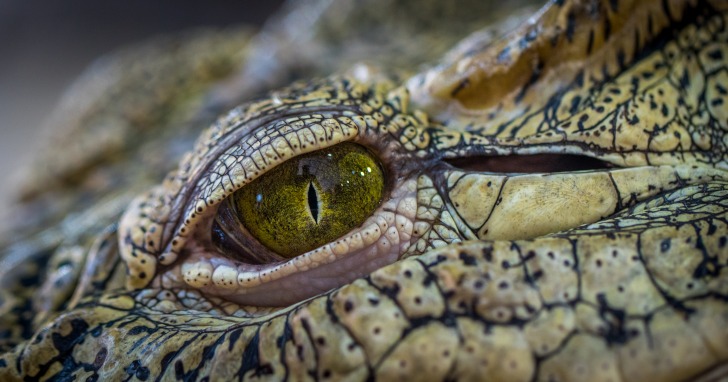Similar to crocodile cousins, but friendlier, are alligators.
Although it’s natural to be terrified of these animals because they appear strong, as long as you don’t disturb them, there shouldn’t be any cause for concern.
Alligators are far more frightened of people than you may think.
While alligators resemble crocodiles, the two are distinctly different.
This guide has all you need to know about these animals.

Contents
- So, Are There Alligators in Indiana?
- Alligator Species in Indiana
- Is it Safe to Swim in Indiana?
- Interesting Alligator Facts in Indiana
- Alligators can walk
- Alligators possess exceptional hearing
- Male gators have a unique courtship style
- An alligator can have 3,000 in its lifespan
- Alligators aren’t out to get us
- Alligators have luminescent eyes.
- Avoid running away in a zigzag motion
- Alligators care for their young ones
- The temperature of the eggs determines the gender of the young alligators
- Alligators can climb
- Crocodiles vs. Alligators
- 3 Safety Tips for Swiming in Alligator-infested Waters
- Summary
- Indiana Safety Overview
- Frequently Asked Questions
So, Are There Alligators in Indiana?
Although residents of Indiana have occasionally discovered alligators in their state, gators don’t natively live in Indiana.
Yet, in the recent past, an alligator was seen in Plymouth, a northern Indiana city.
Residents of Plymouth refer to the alligator as “Ali” with affection.
Two teenage lads discovered the gator while fishing in a local pond and spotted something devouring their bait.
The boys’ families were so shocked by their revelation that they informed the authorities immediately, who went on a hunt to catch the gator.
The hunt for Ali was ultimately successful when a skilled alligator hunter and another guy caught Ali after luring her to the shore with a frog.
Most alligators seen at residences may be pets who have been let free by their owners or broken free from their holdings.
However, you can see alligators in sanctuaries such as Indianapolis Zoo and Turkey Run State Park.
Alligator Species in Indiana
In Indiana, there are no alligators.
Is it Safe to Swim in Indiana?
Swimming in Indiana waters is tricky because of the high rate of pollution in the water.
Streams like the Wabash River contain E. coli, iron, and excessive nutrients, among other problems with biological integrity.
Indiana also features a lot of blue-green algae cells in most of its lakes.
People exposed to blue-green algae may experience rashes, become ill, worst case scenario, pass away.
Interesting Alligator Facts in Indiana
Despite being hideous, alligators are pretty fascinating creatures.
Here are a few facts about these reptiles you probably didn’t know:
Alligators can walk
While gators primarily live in water, they can run, walk, and crawl on land.
There are two types of walks: high walks and low walks.
The alligator lifts its belly off the ground during the high walk as opposed to the low walk, where it sprawls.
Alligators possess exceptional hearing
Due to their excellent hearing, alligators can locate the origin of sounds with great accuracy due to their broad, air-filled tubes dividing the creature’s ears.
Male gators have a unique courtship style
The male gator bellows to entice the females as the spring breeding season gets underway because the indistinct bellows can cause the water around the male to sway and dance.
This technique is enticing to the female gator.
Other mating behaviors include blowing bubbles, banging their head on the water, and caressing their back and snout.
An alligator can have 3,000 in its lifespan
Alligators can have up to 80 teeth in their mouths at once, albeit only a few are noticeable.
New teeth are replaced as the old ones become worn down. An alligator can lose up to 3,000 teeth throughout its lifetime.
Alligators aren’t out to get us
Alligators are naturally afraid of people. In the wild, an alligator is more inclined to flee than to attack.
This doesn’t dismiss the fact that you should avoid interacting with alligators.
These reptiles can get ruthless, so avoid them.
Alligators have luminescent eyes.
Alligators’ eyes are on their heads, allowing them to lie almost totally in the water yet still observe their prey.
Alligators, like cats, have a component at the back of their eyes that reflects light to enhance their night vision.
You can see a red glow in an alligator’s eyes by shining a flashlight.
Avoid running away in a zigzag motion
It’s a popular misconception that an alligator will slow down if you run in a zigzag motion away from it since it won’t be able to change directions rapidly.
Well, this is contrary to the truth.
Running back and forth will significantly reduce the distance between you and the alligator.
If there is any delay in your escape, the gator could be able to locate you sooner.
Backing away from an enraged alligator while lifting your hands in the air and making yourself look as big as you can is a more practical escape strategy.
The alligator frequently retreats after doing this.
If the alligator doesn’t move, your best bet is to run as fast as you can in a straight line.
Alligators care for their young ones
The mother reptile provides a safe and nutritious environment for her young for around two years while she carries them.
Despite their reputation as vicious killers, they are known to be highly protective of their young.
A year is enough time for a baby to develop approximately a foot, making it a sizable predator when it strikes on its own.
The temperature of the eggs determines the gender of the young alligators
The location of an alligator’s nest significantly impacts whether its young will be male or female.
Alligators lack sex-specific chromosomes; hence their gender is virtually always decided by the temperature at which they hatch.
It can significantly affect whether an alligator builds its nest along a river in direct sunshine or a cooler, shaded location.
Most alligators born from eggs that hatch at around 86 degrees Fahrenheit are females.
In contrast, most male alligators are born from eggs that hatch at about 91 degrees Fahrenheit.
Alligators can climb
If you’ve heard that the quickest way to escape an alligator is to leap a fence or climb a tree, don’t take that advice too literally.
Gators, especially young ones, are reasonably agile climbers due to their massive muscular mass, razor-sharp claws, and strong tails.
Alligators can frantically scramble over a fence or wall using their short tail.

Crocodiles vs. Alligators
Both crocodiles and alligators are not natively found in Indiana except on rare occasions.
While most people commonly use the names interchangeably, crocodiles and alligators are distinctly different despite their vast resemblance.
Here are a few ways in which these two differ:
Habitat
Alligators flourish in fresh water, whereas crocodiles require salty water to survive.
Crocodiles have lingual salt glands on their tongues that help them eliminate extra salt from their bodies.
While alligators also have a salt gland but a low tolerance for salt water.
These variations in salt tolerance may potentially explain the variations in their global spread.
Alligator species are primarily found in North and South America, whereas crocodile species can be found in the Americas, Africa, Asia, and Australia.
Difference in snouts
Crocodiles have a long, V-shaped nose, but gators have a broad, short, and U-shaped nose.
The shape of an alligator’s snout is probably different from a crocodile’s due to the latter’s preference for general prey like fish and mammals, as well as its diet and eating habits.
Behavior
Many people believe crocodiles to be far more vicious than alligators.
Alligators are frequently more gentle than crocodiles, only biting when provoked or in need of food, even though you should always avoid contact with both species.
Because they are more active in the water, crocodiles are known to attack only because something or someone is nearby.
Some zookeepers can clean alligator ponds around alligators without provoking a response.
Crocodiles are nearly always aggressive.
Difference in color
Crocodiles and alligators are easily distinguished from one another based on their coloring.
Depending on the colors of their surroundings, different crocodile species can be seen in a range of tones.
The four standard colors of crocodiles are green, grey, brown, and black, while most crocodiles in America have a slate gray exterior and a white to golden bottom.
On the other hand, alligators typically range in hue from dark green to black.
The American alligator has a glossy dark green hue that can almost appear black under some lighting conditions, and its hue is much deeper than a crocodile’s.
Mating
Female alligators will frequently mate with the same male alligator for most of their lives, while crocodiles frequently experience many matings.
3 Safety Tips for Swiming in Alligator-infested Waters
Although typically, you should never come close to alligator-infested waters, if you’re an adrenaline junkie and want to test your limits, here are a few precautions to take:
Never feed an alligator while in the water
Alligators may not be as vicious as crocodiles, but this doesn’t mean you cross boundaries and treat them as pets while in the water.
Giving food to these wild animals encourages them to approach people and gives them the confidence to attack.
Keep your distance
Even though alligators are unlikely to attack, you should always maintain a safe distance of around 60 feet between you and an adult alligator in the water.
If the alligator hisses at you, you are too close.
Never swim alone
If avoiding a lake with alligators is not something you want to do, at least never swim alone.
Handling an attack with a friend or loved one is better than doing it alone.
Summary
If you want to travel to an area with alligators, Indiana may not be the ideal place, but there are still many more activities to explore there.
Nonetheless, alligators are fascinating animals.
In fact, since alligators live in freshwater habitats like rivers, marshes, and lakes, they are representations of spiritual purification and healing.
Alligators are also used as symbols of authority and rank in several Native American traditions.
Indiana Safety Overview
READ THE FULL REPORT: Indiana Safety Review
Safety Index:
- OVERALL RISK: MEDIUM
- TRANSPORT & TAXIS RISK: LOW
- PICKPOCKETS RISK: LOW
- NATURAL DISASTERS RISK: LOW
- MUGGING RISK: MEDIUM
- TERRORISM RISK: MEDIUM
- SCAMS RISK: LOW
- WOMEN TRAVELERS RISK: MEDIUM
Frequently Asked Questions
How many individuals per year pass away from alligator attacks?
Unlike crocodile attacks, alligator assaults aren’t common.
Alligators often swim or stroll away in terror to avoid contact with humans.
In Indiana, are alligators able to be pets?
In Indiana, keeping an alligator as a pet is entirely permitted, and a permit is required for alligators longer than five feet.
Do alligators attack humans?
Alligators are peaceful animals that are cautious around people.
Most of the time, when an alligator sees a man, it will turn away.
Alligators rarely attack intentionally; they only do it to protect their nest, young, or in self-defense.












Alligators are not native to Indiana, but there have been occasional sightings of them in the state.